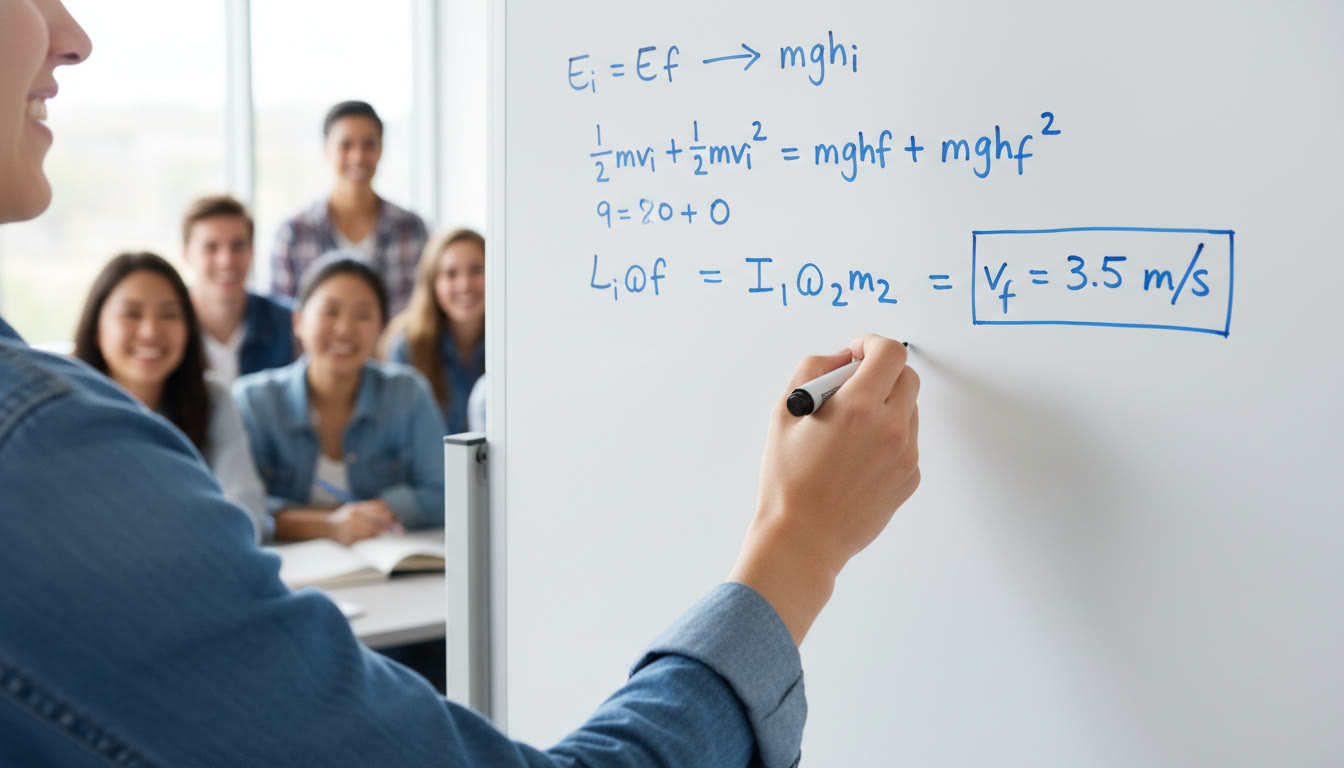Welcome: Why Mixed Sets Matter
There’s something thrilling about a problem that blends rotation, energy, and momentum — it forces you to think like a physicist, not like someone following a recipe. On AP exams and in real-world physics, the ability to move fluidly between translational and rotational ideas, between energy bookkeeping and momentum snapshots, is what separates good students from great ones.

In this blog you’ll find a warm, conversational walkthrough of the most important concepts, examples that tie ideas together, a strategy for attacking mixed problems, and a compact study plan you can actually follow. Where it fits naturally, I’ll mention how Sparkl’s personalized tutoring can help with 1-on-1 guidance and tailored study plans to accelerate progress.
Core Concepts Refresher (Short and Sweet)
Rotation Basics
Think of rotation as translation in a magic mirror: where linear motion uses x, v, a, m — rotation uses θ (angle), ω (angular velocity), α (angular acceleration), and I (moment of inertia). Key relations you’ll use constantly are:
- v = ωr (linear speed at radius r)
- a_tangential = αr, a_centripetal = ω²r
- Torque τ = r × F = Iα
Energy: Work and Rotational Kinetic Energy
Energy is bookkeeping. For rotating bodies, rotational kinetic energy is KR = (1/2)Iω². A system with both translation and rotation has total kinetic energy K = (1/2)mv² + (1/2)Iω². Remember to choose the correct axis when computing I.
Momentum and Angular Momentum
Linear momentum p = mv and angular momentum L can appear in two flavors:
- For point masses about an origin: L = r × p
- For rigid bodies rotating about an axis: L = Iω
Conservation of linear momentum holds when external net force is zero; conservation of angular momentum holds when external net torque about the chosen axis is zero.
Strategy: How to Tackle a Mixed Hard Problem
Hard mixed problems look messy because they combine:
- Rotational dynamics (torques, moments of inertia)
- Energy conservation or nonconservative work
- Momentum or impulse events (collisions, drops)
Use this step-by-step approach:
- Read the whole problem first. Identify conservation laws that might apply at different stages (energy, momentum, angular momentum).
- Break the problem into phases: before/after impact, during contact, rolling vs. sliding, etc.
- Choose coordinate axes and rotational axes wisely. Place the origin where it simplifies torque or angular momentum calculations.
- Write down what’s conserved in each phase. Often angular momentum is conserved during a collision if external torques are negligible at that instant.
- Convert between linear and rotational quantities as needed (v = ωr, KE total = translational + rotational).
- Check limiting cases: what happens if m → 0, r → 0, frictionless, or perfectly inelastic? This helps verify your algebra and units.
Worked Example 1: A Classic Collision With Rotation
Problem Setup (Conceptual)
Imagine a small puck of mass m traveling at speed v that collides and sticks to the rim of a uniform thin disk of mass M and radius R that is initially at rest and free to rotate about its center. Find the final angular speed ωf right after the collision, and compute the loss of kinetic energy.
Step-by-Step Solution
Phase identification: This is an instant collision (impulsive), so angular momentum about the disk center is conserved (external torque about that center is zero during the short impulse if the support exerts no torque about the center).
- Initial angular momentum: puck gives L_i = m v R (since r = R and L = r × p = R · m v).
- Final angular momentum: L_f = I_total ωf, where I_total = I_disk + I_puck. For a thin disk I_disk = (1/2) M R². The puck stuck at rim acts like a point mass I_puck = m R².
- Set L_i = L_f: m v R = (1/2 M R² + m R²) ωf.
- Solve for ωf: ωf = (m v R) / (R²(1/2 M + m)) = (m v) / (R(1/2 M + m)).
Energy accounting: initial KE = (1/2) m v². Final KE = (1/2) I_total ωf² = (1/2) (1/2 M R² + m R²) ωf². Plug ωf and compare — you’ll find KE decreases because the inelastic sticking converts some kinetic energy into internal energy.
Key Takeaways
- Angular momentum conservation gave ωf directly; energy was not conserved through the collision because the collision is inelastic.
- Checking extreme cases helps sanity-check: if M → 0 (light disk), ωf → v/R (puck dominates). If m ≪ M, ωf is tiny.
Worked Example 2: Rolling Without Slipping Meets Energy
Problem Setup
A solid sphere of mass m rolls without slipping down a ramp of height h. Find its speed at the bottom and compare it to a frictionless block of the same mass sliding down the same ramp.
Solution Sketch
- Use energy conservation: m g h (initial potential) = K_trans + K_rot at bottom = (1/2) m v² + (1/2) I ω².
- For a solid sphere I = (2/5) m r² and ω = v/r. Plugging in gives m g h = (1/2) m v² + (1/2) (2/5 m r²) (v²/r²) = (1/2 + 1/5) m v² = (7/10) m v².
- Solve: v = sqrt((10/7) g h).
Compare to frictionless block: v_block = sqrt(2 g h). The rolling sphere is slower because some energy is tied up in rotation.
Worked Example 3: A Mixed Scenario — Pivot, Rope, and Sliding Mass
Problem Outline
Consider a uniform rod of length L and mass M pivoted about one end with negligible friction. A small mass m attached to the free end is released from rest at horizontal position and swings down. Find the angular speed when the rod passes vertical and the linear speed of the small mass. Then determine the impulse delivered to the pivot if the rod strikes a buffer at the bottom and stops suddenly (assume inelastic stop).
Phase 1: From Horizontal to Vertical (Use Energy)
Initial potential energy: both rod and mass drop a vertical distance. For the rod, center of mass falls by L/2; for the mass, it falls by L. So initial PE = M g (L/2) + m g L. At bottom, energy is rotational KE only: (1/2) I_total ω², where I_total = I_rod_about_end + m L², and I_rod_about_end = (1/3) M L².
- m g L + (1/2) M g L = (1/2) ((1/3) M L² + m L²) ω²
- Solve for ω: ω = sqrt((2 g L (m + M/2)) / (L² (m + M/3))) = sqrt((2 g (m + M/2)) / (L (m + M/3))).
Linear speed of mass: v = ω L.
Phase 2: Sudden Stop and Impulse
If the rod stops instantly against a buffer, angular momentum is not conserved because external torque from the pivot/buffer acts during the stop. But impulse delivered to pivot equals change in angular momentum about the pivot during the collision.
- Initial angular momentum before stop: L_i = I_total ω.
- Final angular momentum: 0. Impulse (about pivot) Jθ = -L_i. The magnitude tells you how much torque-time product the pivot experienced.
Converting to linear impulse on pivot would depend on geometry; the important conceptual point: impulses can be found from angular momentum change when torques are large but act over a short time.
Practice Problems (Mini Set)
Work through these on paper. Try to avoid looking at the solutions immediately—force yourself to outline the conserved quantities first.
- 1) A ring (I = M R²) and a disk (I = 1/2 M R²) both start from rest at the same height on identical ramps. Which reaches the bottom faster? Explain with energy reasoning.
- 2) A bullet of mass m and speed v embeds in a stationary cylinder of mass M and radius R. Find the post-collision ω and the fraction of kinetic energy lost.
- 3) Two identical disks mounted on frictionless axles move toward each other, stick with a connecting massless rod. Use conservation of angular momentum to find the final angular speed.
One-Page Cheat Table
| Quantity | Rotational Form | Notes |
|---|---|---|
| Position | θ (radians) | Use radians for energy and kinematics |
| Velocity | ω (rad/s) | Relate to linear: v = ω r |
| Mass | I (moment of inertia) | Add point masses as m r²; use standard formulas for common shapes |
| Newton’s Law | τ = I α | Torque about axis — sign and direction matter |
| Kinetic Energy | K = (1/2)mv² + (1/2)Iω² | Remember both terms if center of mass translates |
| Momentum | p = mv | Use for collision conservation when net external force ≈ 0 |
| Angular Momentum | L = r × p or L = Iω | Choose axis where external torque is zero for conservation |
Common Pitfalls and How to Avoid Them
- Mixing up axes: Always compute I about the same axis where you apply angular momentum conservation.
- Forgetting rotational kinetic energy: If an object is rolling, don’t omit the (1/2) Iω² part.
- Applying energy through an inelastic collision: Energy is not conserved when sticking or dissipation happens — use momentum or angular momentum instead.
- Units and factors: Watch for factors like 1/2, 2/5, 1/3 that originate from shapes’ I formulas.
How to Practice Efficiently (Weekly Plan)
Consistency beats cramming. Here’s a 6-week micro-plan if you have a limited window before an AP test or a unit exam:
- Week 1: Solidify basics — review rotational kinematics and moments of inertia. Do 10 focused problems on v = ωr, τ = Iα.
- Week 2: Energy focus — do energy conservation problems that include rotation (rolling items down inclines, combined translation + rotation).
- Week 3: Momentum and collisions — point-particle collisions, bullets embedding in rotors, and angular momentum conservation scenarios.
- Week 4: Mixed sets — solve multi-stage problems that require switching between conservation laws. Time yourself.
- Week 5: Timed practice sections — mimic exam conditions. Identify recurring weak points and review targeted concepts.
- Week 6: Final polishing — revisit errors, run through conceptual flashcards, and practice explaining solutions aloud (teaching is the fastest way to solidify understanding).
If you want personalized pacing or help identifying which problems to prioritize, Sparkl’s personalized tutoring can build a tailored study plan, offer 1-on-1 guidance, and provide expert tutors plus AI-driven insights to maximize your study time.
Exam-Day Mindset and Problem Checklist
On test day, you’re not being graded for how many formulas you can recite — you’re being graded for how clean, logical, and efficient your physics thinking is. Before you commit to an answer:
- Have you labeled axes, directions of angular velocity, and signs for torques?
- Did you identify which conservation principles apply in each phase?
- Did you check the units and limiting cases?
- Is your final expression physically reasonable (e.g., speeds positive, energy nonnegative)?
Quick Reference: Moments of Inertia (Common Shapes)
| Object | Axis | I |
|---|---|---|
| Thin Ring | Center, about axis perpendicular to plane | MR² |
| Solid Disk | Center, about axis perpendicular to plane | (1/2)MR² |
| Solid Sphere | Center | (2/5)MR² |
| Thin Rod | Center, perpendicular | (1/12)ML² |
| Thin Rod | About end | (1/3)ML² |
Final Tips — Thinking Like an AP Physics Pro
- Sketch a quick diagram even if the problem includes one. Annotate velocities, ω, r, and directions of torques and impulses.
- Use conservation laws selectively — they’re powerful but only when their conditions are met. State those conditions in your solution to earn partial credit if you’re on the AP free-response section.
- When stuck, simplify: replace complex shape with point masses to get a sense of the answer’s behavior, then add complexity back in.
- Practice explaining solutions aloud or to a study partner — teaching reveals gaps and solidifies knowledge.
Want Personalized Help?
Mixed rotation-energy-momentum questions are among the most rewarding — and the most practice-amenable. If you want tailored problem sets, 1-on-1 walkthroughs, and a study schedule tuned to your strengths and weaknesses, Sparkl’s personalized tutoring can give you the extra structure and expert feedback to accelerate improvement. A few focused sessions can transform confusion into reliable technique.
Parting Encouragement
Hard sets don’t mean unsolvable sets. They mean opportunities to build intuition, pattern recognition, and the kind of flexibility that lasts beyond any single exam. Approach problems like puzzles: break them into parts, apply the right conservation laws, check limits, and write clean steps. With steady practice and the occasional targeted help — from a tutor, peer, or a smart study resource — you’ll not only get the answers but understand why they make sense.

Good luck — and remember: the physics is always more elegant than it first appears. Keep solving, keep checking edge cases, and enjoy the clarity that comes when pieces start clicking together.



















No Comments
Leave a comment Cancel